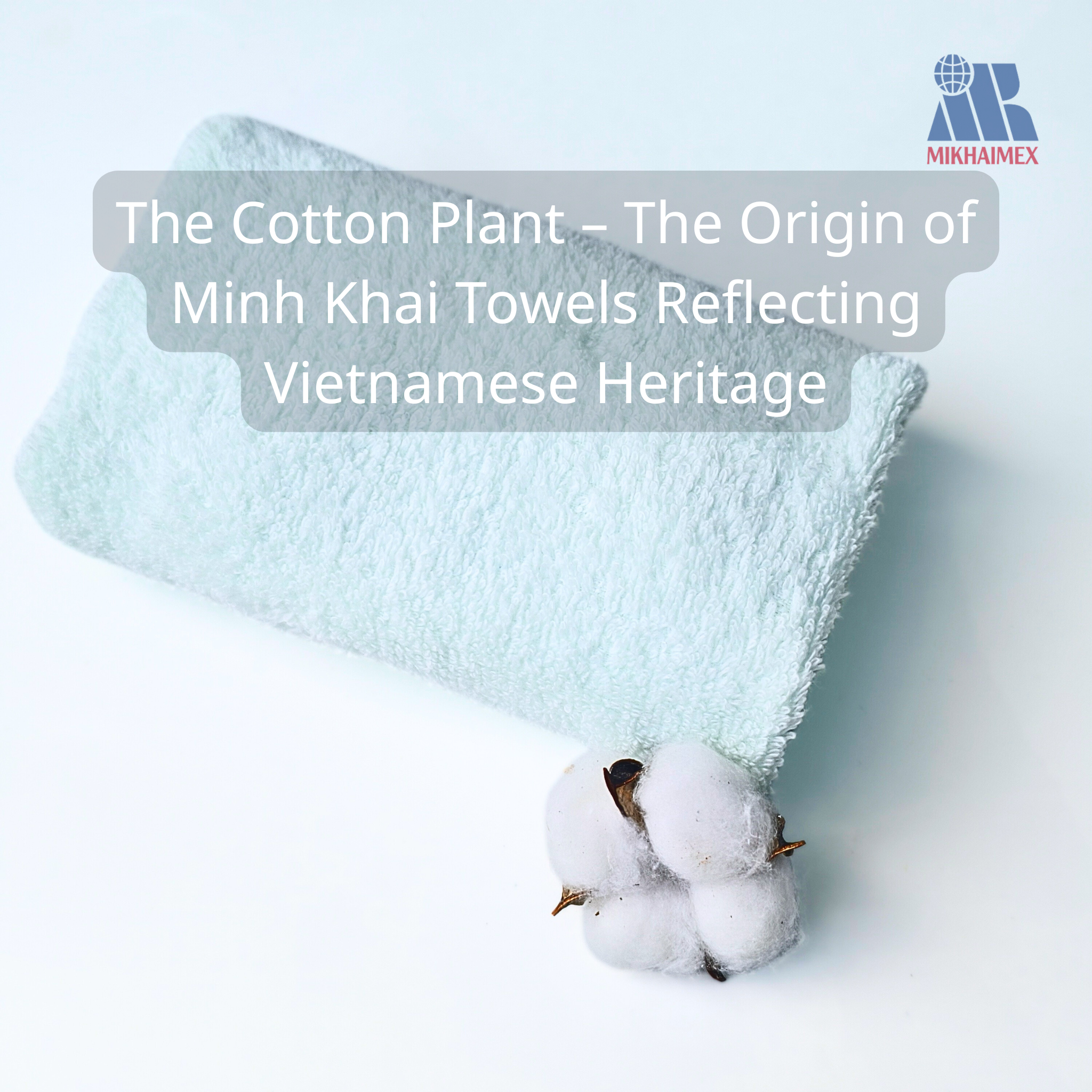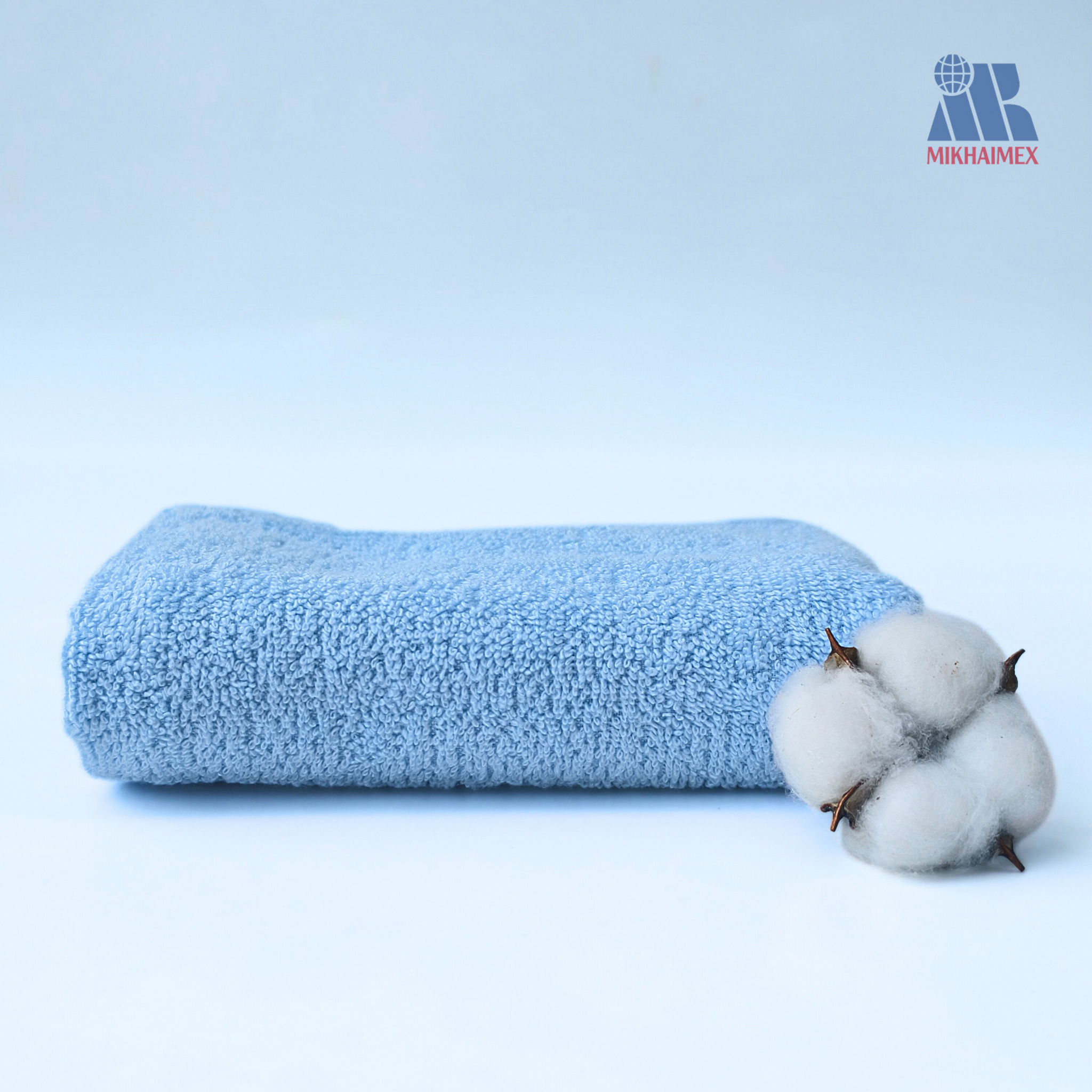The Cotton Plant – The Origin of Minh Khai Towels Reflecting Vietnamese Heritage
1. Cotton – A Gift from Nature to Humanity

In the natural world, there are plants that seem ordinary yet are deeply intertwined with human life, creating lasting values across generations. The cotton plant is one of them. Since ancient times, people have cultivated cotton for its fibers, which are spun and woven into fabrics to make clothing, towels, blankets, and countless familiar items. Whether in ancient civilizations or the modern era, cotton has always played an essential role in both the economy and daily life.
Cotton, also known as Gossypium or kapok in some regions, belongs to the mallow family and is a short-term industrial crop. When the fruit matures, the outer shell splits open to reveal soft, white fibers. These fibers are harvested and processed into yarn for weaving fabric. From a tiny seed, the cotton plant requires months of care before producing soft, clean, and durable fibers.
Throughout human history, cotton has been cultivated across many civilizations. Archaeological evidence shows that cotton fibers were used more than 7,000 years ago in India and the Americas. Today, cotton is widely grown in tropical and subtropical regions such as India, China, the United States, Brazil, Pakistan, Egypt, and Vietnam.
Cotton provides not only valuable textile fibers but also diverse by-products. Cottonseed can be pressed for edible oil, while the remaining meal is used for animal feed. The stems and husks are used as fuel or organic fertilizer. For that reason, cotton is considered a versatile industrial crop that contributes significantly to agricultural and economic development in many countries.
Cotton stands as a symbol of the close connection between humans and nature. Its fibers represent not only raw material but also the spirit of labor, craftsmanship, and creativity — the very foundations upon which the textile industry thrives.
2. From Seed to Fluffy White Fiber
To produce soft, pure white cotton fibers, farmers must go through a meticulous cultivation process. Cotton thrives best in loose, fertile soil with good drainage and neutral pH levels. It prefers sunny, dry climates, as excessive humidity can reduce fiber quality or cause pest infestations.
The journey begins with seed selection. High-quality cotton varieties produce long, uniform fibers with a natural luster. After sowing, the seeds germinate within 5 to 10 days, gradually growing into leafy green plants. When the plants reach 40–60 days old, they begin to bloom. Cotton flowers are initially white, then turn yellow or pink — a sign that the fruit is forming.
Each cotton boll contains 20–30 seeds. As it ripens, the boll bursts open, revealing the soft, fluffy fibers inside. Farmers must harvest at just the right time — too early and the fibers are underdeveloped; too late and they risk moisture damage or contamination. Today, depending on the scale of production, cotton is harvested either manually or with specialized machinery.
Once picked, the cotton goes through the ginning process, where machines separate the seeds from the fiber. The fibers are then cleaned, carded, and spun into yarn. These yarns are wound onto large spools, ready to be woven into fabric.
To produce finished goods like towels, cotton fabrics, or clothing, the yarn undergoes additional stages such as bleaching, dyeing, finishing, and quality inspection. Each step demands precision and skill to preserve the cotton’s natural softness while ensuring durability and colorfastness.
Thus, the cotton plant is not merely an agricultural crop — it marks the beginning of a sophisticated industrial chain that combines traditional craftsmanship with modern technology.
3. The Remarkable Qualities of Cotton Fiber
Cotton is the most widely used natural fiber in the world, accounting for more than one-third of global textile production. Despite the emergence of many synthetic fibers, cotton maintains its dominance thanks to its exceptional natural properties that are hard to replace.
First, cotton has excellent moisture absorption — it can absorb several times its own weight in water without deforming. This makes cotton products feel dry, cool, and comfortable on the skin. That is why cotton remains the preferred choice for towels, shirts, baby clothes, and underwear — all items that require softness and breathability.
Second, the natural twisted structure of cotton fibers allows air to circulate easily, making cotton fabrics soft, cool, and breathable — ideal for tropical and humid climates like Vietnam’s.
In addition, cotton is durable, resistant to heat during washing or ironing, and easy to clean. It is hypoallergenic, making it suitable even for sensitive skin. Compared to synthetic fibers, cotton is also environmentally friendly because it is fully biodegradable.
Cotton’s versatility in manufacturing is another key advantage. By adjusting weaving density, finishing methods, and yarn types, producers can create a wide range of textiles — from coarse fabrics to fine linens and premium towels. As such, cotton serves not only everyday needs but also forms the basis for industries like fashion, interior design, and healthcare.
It’s no coincidence that people in the textile world often say: “Where there is cotton, there is a flourishing textile industry.” Cotton truly forms the backbone of numerous related industries — from spinning, weaving, and dyeing to printing, embroidery, and garment production.
4. Cotton Cultivation and the Path Toward Sustainability
Today, as the world embraces a green economy, the cotton industry faces increasing demands for sustainable practices. Although cotton is an economically valuable crop, traditional cultivation faces challenges due to its high water and nutrient requirements. Climate change and resource scarcity have made farming more difficult than ever.
The use of fertilizers and pesticides is another concern. To reduce negative environmental impacts, many major cotton-producing regions are transitioning toward sustainable farming practices. This shift has led to the rise of organic cotton — grown without synthetic chemicals, with efficient water use, and with a focus on biodiversity preservation.
This transformation is not merely a trend but a commitment shared by leading textile companies worldwide. Consumers today care deeply about product origins and environmental impacts. Brands that adopt organic cotton not only enhance their product value but also demonstrate social responsibility and transparency.
In Vietnam, the warm, sunny climate and fertile soils in regions such as the Central Highlands and South Central Coast are suitable for cotton cultivation. Although domestic cotton production remains modest, Vietnam’s textile industry continues to invest in modern technology to maximize the value of locally sourced cotton for yarn, fabric, and towel manufacturing.
One shining example is the collaboration between cotton farmers and Minh Khai Textile Company. With extensive experience and modern production technology, Minh Khai transforms pristine white cotton fibers from local farms into soft, durable, and elegant towels. This partnership not only increases the value of agricultural produce but also strengthens the position of Vietnamese-made products in both domestic and international markets. It represents a sustainable production model that connects raw material sources with high-quality finished goods, benefiting both farmers and factories alike.
5. Minh Khai Textile Company – Transforming Cotton into Towels that Embody Vietnamese Values

When talking about Vietnam’s towel manufacturing industry, one cannot overlook Minh Khai Textile Company — a factory with decades of experience and a reputation for quality. From natural cotton fibers, Minh Khai has continuously invested in research, innovation, and technology to produce premium towels that meet the increasingly demanding expectations of consumers.
Every Minh Khai towel is the result of a meticulous process, monitored from raw material selection to final inspection. Only the finest cotton is chosen, ensuring fiber length, brightness, and softness. The fibers are spun, woven, dyed, and finished on advanced automated lines, preserving the cotton’s natural properties while enhancing strength and color vibrancy.
Beyond production excellence, Minh Khai is deeply committed to eco-friendly practices. The company applies energy-efficient, low-impact dyeing and washing technologies that reduce water use and chemical waste. This sustainable approach has made Minh Khai’s cotton towels highly popular not only in Vietnam but also in international markets.
In addition to standard manufacturing, Minh Khai offers custom towel printing, embroidery, and private-label services, catering to hotels, spas, corporate gifting, and traditional craft villages. This strategic diversification allows the company to reach a wider customer base while reinforcing its role as a pioneer in Vietnam’s textile industry.
At Minh Khai, every cotton product is more than just merchandise — it is the embodiment of Vietnamese craftsmanship, labor, and pride. The company remains dedicated to constant improvement, striving to deliver soft, refined towels that carry the distinctive mark of a trusted Vietnamese brand.
Conclusion
Cotton is far more than an industrial crop — it is a symbol of creativity, vitality, and the harmonious connection between humans and nature. From a tiny seed to delicate white fibers, the journey of cotton reflects hard work, perseverance, and innovation.
In the evolving landscape of Vietnam’s textile industry, Minh Khai Textile Company stands out as a bright example. From natural cotton, Minh Khai produces 100% cotton towels that embody quality, integrity, and creativity. Its products not only serve domestic needs but also reach demanding markets such as the United States, Japan, South Korea, and the European Union, spreading Vietnamese value and craftsmanship across the globe.


